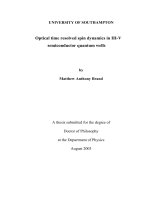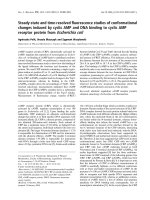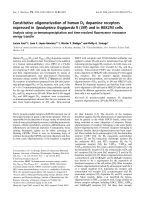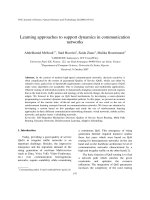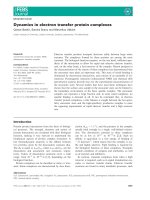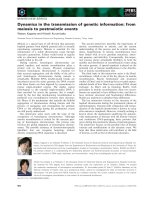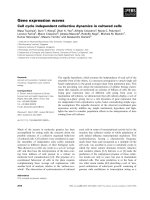Optical time resolved spin dynamics in III-V semiconductor quantum wells
Bạn đang xem bản rút gọn của tài liệu. Xem và tải ngay bản đầy đủ của tài liệu tại đây (2.61 MB, 157 trang )
UNIVERSITY OF SOUTHAMPTON
Optical time resolved spin dynamics in III-V
semiconductor quantum wells
by
Matthew Anthony Brand
A thesis submitted for the degree of
Doctor of Philosophy
at the Department of Physics
August 2003
UNIVERSITY OF SOUTHAMPTON
ABSTRACT
FACULTY OF SCIENCE
Doctor of Philosophy
“Optical time resolved spin dynamics in III-V semiconductor
quantum wells”
Matthew Anthony Brand
This thesis presents time-resolved measurements of the spin evolution of transient carrier
populations in III-V quantum wells. Non-equilibrium distributions of spin polarisation were
photoexcited and probed with picosecond laser pulses in three samples; a high mobility
modulation n-doped sample containing a single GaAs/AlGaAs quantum well, an
In
0.11
Ga
0.89
As/GaAs sample containing three quantum wells and, a multi-period GaAs/AlGaAs
narrow quantum well sample.
Electron spin polarisation in low mobility wells decays exponentially. This is successfully
described by the D’yakonov-Perel (DP) mechanism under the frequent collision regime, within
which the mobility can be used to provide the scattering parameter. This work considers the
case of a high mobility sample where collisions are infrequent enough to allow oscillatory spin
evolution. It is shown however, that in n-type quantum wells the electron-electron scattering
inhibits the spin evolution, leading to slower, non-oscillatory, decays than previously expected.
Observed electron spin relaxation in InGaAs/InP is faster than in GaAs/AlGaAs. This may
be ascribed to an enhanced DP relaxation caused by Native Interface Asymmetry (NIA) in
InGaAs/InP, or to the differing natures of the well materials. Here the two possibilities have
been distinguished by measuring electron spin relaxation in InGaAs/GaAs quantum wells. The
long spin lifetime implicates the NIA as the cause of the fast relaxation in InGaAs/InP.
Finally, the reflectively probed optically induced linear birefringence method has been used
to measure quantum beats between the heavy-hole exciton spin states, which are mixed by a
magnetic field applied at various angles to the growth direction of the GaAs/AlGaAs
multi-quantum well sample within which the symmetry is lower than D
2d
. Mixing between the
optically active and inactive exciton spin states by the magnetic field, and between the two
optically active states by the low symmetry, are directly observed.
This thesis is dedicated to my parents.
Acknowledgments
Many people have made my time at the Department of Physics in Southampton enjoyable,
interesting and educational. In particular I would like to thank: Richard Harley for excellent
supervision and much encouragement over the years; Andy Malinowski who as a postdoc in
the early part of this work taught me much about how to obtain useful results actually and
efficiently; Phil Marsden for his technical assistance and many useful discussions; Jeremy
Baumberg, David Smith, Geoff Daniell and Oleg Karimov who have clarified some specific
physics topics I was having difficulties with.
I would also like to thank my family whose support and encouragement has made this
possible.
Contents
1. Introduction____________________________________________________________ 1
2. Electrons in III-V semiconductor heterostructures_____________________________ 4
3. Time-resolved measurement method _______________________________________ 16
4. Electron-electron scattering and the D’Yakonov-Perel mechanism in a high mobility
electron gas
_______________________________________________________________ 22
4.1 Introduction _______________________________________________________ 22
4.2 Background _______________________________________________________ 23
4.3 Theory ____________________________________________________________ 25
4.3.1 Conduction band spin-splitting and the D’yakonov-Perel mechanism _______ 25
4.3.2 Evolution of spin polarisation excited in the valance band ________________ 28
4.3.3 Energy distribution of the electron spin polarisation _____________________ 29
4.4 Sample description__________________________________________________ 32
4.4.1 Sample mobility _________________________________________________ 34
4.4.2 Optical characterisation ___________________________________________ 36
4.5 Experimental procedure _____________________________________________ 38
4.6 Results____________________________________________________________ 38
4.7 Analysis___________________________________________________________ 44
4.7.1 Monte-Carlo simulation ___________________________________________ 45
4.7.2 Electron-electron scattering ________________________________________ 47
4.7.3 Spectral sampling of the conduction band spin-splitting and anisotropy ______ 48
4.8 Summary and conclusions____________________________________________ 55
4.9 References_________________________________________________________ 57
5. Spin relaxation in undoped InGaAs/GaAs quantum wells ______________________ 60
5.1 Introduction _______________________________________________________ 60
5.2 Background and theory______________________________________________ 61
5.2.1 Exciton spin dynamics ____________________________________________ 62
5.2.2 Effects of temperature_____________________________________________ 67
5.3 Sample description__________________________________________________ 71
5.4 Experimental procedure _____________________________________________ 71
5.5 Results____________________________________________________________ 74
5.6 Analysis___________________________________________________________ 94
5.7 Interpretation______________________________________________________ 99
5.7.1 Phases in the evolution of the excited population_______________________ 100
5.7.2 Exciton thermalisation ___________________________________________ 101
5.7.3 Thermalised excitons ____________________________________________ 103
5.7.4 Comparison with InGaAs/InP, the Native Interface Asymmetry___________ 107
5.7.5 Dynamics of the unbound e-h plasma and carrier emission _______________ 108
5.8 Summary and conclusions___________________________________________ 112
5.9 References________________________________________________________ 114
6. Exciton spin precession in a magnetic field_________________________________ 117
6.1 Introduction ______________________________________________________ 117
6.2 Background and theory_____________________________________________ 118
6.3 Sample description_________________________________________________ 124
6.4 Experiment _______________________________________________________ 125
6.5 Results___________________________________________________________ 127
6.6 Summary and Conclusions __________________________________________ 140
6.7 References________________________________________________________ 141
7. Conclusions__________________________________________________________ 143
7.1 References________________________________________________________ 146
8. List of Publications ____________________________________________________ 147
1
1. Introduction
This thesis concerns the optical manipulation of electron spin in III-V semiconductor
heterostructures. It presents measurements of the time evolution of transient spin polarised
carriers on a picosecond timescale.
Some of the information contained in the polarisation state of absorbed light is stored in
the spin component of the excited state of the absorbing medium, it is lost over time due to
processes which decohere or relax the spin polarisation in the medium. How well a material
can preserve spin information is represented by the spin relaxation and decoherence rates,
quantities which depend on many parameters, the principal determinants are temperature;
quantum confinement; and external and internal electromagnetic field configurations,
manipulated for example by doping, and excitation intensity. Hysteresis effects are also
possible in magnetic-ion doped semiconductors. Mechanisms of light absorption and energy
retention in semiconductors can be described in terms of the photo-creation of transient
populations of various quantum quasi-particles; electrons, holes, excitons and phonons being
the most basic kind. Holes and excitons are large scale manifestations of electron
interactions, whereas phonons represent vibrational (thermal) excitations of the crystal lattice.
More exotic wavicles such as the exciton-photon polariton; the exciton-phonon polariton, bi-,
tri- and charged-exciton; and plasmon states are obtained from various couplings between
members of the basic set. It has been found that the basic set of excitations suffice for the
work presented in this thesis.
Many current semiconductor technologies exploit only the charge or Coulomb driven
interactions of induced non-equilibrium electron populations to store, manipulate and
transmit information. It has long been recognised that in addition information of a
2
fundamentally different, quantum, nature may also be carried by the electron spin. Many
proposals for advances in information processing, the development of quantum computing
and spin electronic devices, involve manipulation of spin in semiconductors.
Currently, most mass produced semiconductor devices are Silicon based. From an
economic viewpoint, since the industrial production infrastructure is already in place, spin
manipulation technologies based on Silicon would be most desirable. Silicon is however an
indirect gap semiconductor, it couples only weakly to light, which, in respect of optical spin
manipulation, places it at a disadvantage relative to its direct gap counterparts. Many III-V
(and II-VI) materials are direct gap semiconductors and couple strongly to light. Interest in
research, such as presented here, into the interaction of polarised light with III-V’s for the
purpose of manipulating spin information, has thus grown rapidly over recent years. Gallium
Arsenide has been the prime focus and other materials such as InAs, InP, and GaN are also
under increasingly intense investigation.
It is not only potential further technological reward that motivates spin studies in
semiconductors, they also provide an ideal physical system in which to test and improve
understanding of physical theories. This is because physical parameters, such as alloy
concentrations, temperature, quantum confinement lengths, disorder, and strain to name a
few, can be systematically varied with reasonable accuracy and effort during experimentation
or growth. Theories attempt to relate these parameters to basic physical processes and
measurement results, experiments verify (or contradict) the predictions, and through a
feedback process fundamental understanding can increase and deepen.
The work presented in this thesis is a contribution to this field, the ongoing investigation
of the properties and behaviour of electrons in III-V semiconductors, with emphasis on the
time-resolved dynamics of optically created transient spin polarisations in quantum confined
heterostructures.
3
Laser pulses of ~2 picosecond duration were used to excite a non-equilibrium electron
distribution into the conduction band. Optical polarisation of the laser beam is transferred
into polarisation of the electron spin. Evolution of this injected spin polarisation was
measured using a reflected, weaker, test pulse whose arrival at the sample was delayed.
Rotation of the linear polarisation plane of the test pulse revealed some information
concerning the state that the spin polarisation had reached after elapse of the delay time. A
more detailed description of the measurement method is given in chapter 3.
Three pieces of experimental work have been undertaken in this thesis. Measurements in
a high mobility modulation n-doped (1.86x10
11
cm
-2
) GaAs/AlGaAs sample were designed to
observe the precession of electron spin in the absence of an external magnetic field (see
chapter 4). The spin vectors are thought to precess around an effective magnetic field related
to the conduction band spin-splitting which is caused by the inversion asymmetry of the
Zincblende crystal structure. Spin relaxation in an undoped In
0.11
Ga
0.89
As/GaAs sample was
studied to ascertain whether previously observed fast electron spin relaxation in InGaAs/InP
was due the native interface asymmetry present in the structure or if spin relaxation is
generally fast in InGaAs wells (see chapter 5). Finally, quantum beating of exciton spin
precession was measured in a GaAs/AlGaAs multiple quantum well sample with a magnetic
field applied at various angles to the growth and excitation direction using optically-induced
transient linear birefringence. Previous studies on this sample have shown that some of the
excitons experience a low symmetry environment which lifts the degeneracy of the optically
active heavy-hole exciton spin states. In this study we attempt to observe the effects of this in
time-resolved spectroscopy (chapter 6).
In chapter 2 some basic semiconductor physics relating to the behaviour of electrons is
outlined in sufficient detail to give some perspective to the work presented in subsequent
chapters.
2. Electrons in III-V semiconductor heterostructures
The relation between the electron kinetic energy (E) and momentum (p) is called the
dispersion function and its form can explain many of the properties of electrons in
semiconductors. In free space, ignoring relativistic effects, it is the familiar parabolic function:
E = p
2
/(2m
0
), (2.1)
where m
0
is the electron rest mass. When the electron moves through a material the dispersion
function is modified through interaction with the electromagnetic fields of particles that
compose the material. Its exact form depends on the material system considered and in general
it is a complicated function of many interactions and factors. For small values of
p the
experimentally determined dispersion relation in direct gap III-V semiconductors is well
approximated by a set of parabolic bands with modified particle masses. It should be noted
that the manifold p is not continuous, it forms a quasi-continuum where the distance between
each discrete state labelled by p is small enough to ignore and can be treated as a continuous
variable in most practical work. It is convenient to focus on the wave nature of electrons inside
the lattice and use the electron wave vector,
k = p/ћ. Within the parabolic approximation,
electrons in the conduction band have energies (measured from the top of the valence band):
E= (ћ
2
k
2
)/(2m
e
m
0
) + E
g
, (2.2)
where m
e
is the effective electron mass ratio. E
g
is the band gap, a region of energy values
which electrons cannot possess. In the valence band, the functions can be approximated by the
solutions of the Luttinger Hamiltonian [1]:
4
H = (ћ
2
/(2m
0
)).[(γ
1
+γ
2
5/2)k
2
- 2γ
2
(k
x
2
J
x
2
+ k
y
2
J
y
2
+ k
z
2
J
z
2
)
- 4γ
3
({k
x
.k
y
}{ J
x
.J
y
+ …})],
(2.3)
where γ
n
are the Luttinger parameters which define the valence band, {A.B} is the
anticommutation operator (AB + BA), and J
i
is the i’th component of angular momentum.
Solutions of the Hamiltonian depend on the propagation direction. Defining the z-direction
along the [001] crystal direction and considering electrons propagating along it reveals two
dispersion relations, of the light and heavy-hole valence bands according to J
z
having values
±1/2 and ±3/2 respectively:
E= (γ
1
+2γ
2
).(ћ
2
k
z
2
)/(2m
0
) J
z
=±1/2 (light-electron states),
E= (γ
1
-2γ
2
).(ћ
2
k
z
2
)/(2m
0
) J
z
=±3/2 (heavy-electron states),
(2.4)
thus electrons with J
z
=±1/2 move with effective mass m
0
/(γ
1
+2γ
2
) and those with J
z
=±3/2 with
effective mass m
0
/(γ
1
-2γ
2
).
hν
hν’
E
g
CB
VB
lh
hh
p
E
Figure 2.1: Basic band structure and absorption/emission process in a direct gap
semiconductor. Light of energy hν is absorbed promoting an electron to the
conduction band and leaving a hole in the valence band, the particles relax towards
the band minima and eventually recombine emitting a photon with less energy.
5
Absorption of light in un-doped samples occurs for photon energies (hν) greater than the
band gap (E
g
), resulting in the promotion of an electron from the valence to conduction band
leaving a hole (an unfilled state) in the valence band. The conduction electron will generally
lose energy by emission of phonons, ending near the bottom of the conduction band. Similar
phonon emission by the electrons in the valence band gives the appearance that the hole moves
towards the top of the band. Holes may be either `light` or `heavy` according to their angular
momentum being J
z
=±1/2 or J
z
=±3/2 respectively. The electron and hole may eventually
recombine; the electron falls back to the valence band, the hole disappears, and a photon of
altered energy hν’ is emitted, the process is illustrated in figure 2.1. By momentum
conservation and because the photon momentum is negligible, the electron and hole must have
wave vectors of roughly equal and opposite magnitude for absorption/emission to occur. That
is, only vertical transitions in E(k) vs. k space are allowed.
The energy gap of a structure is a function of the material composition and mesoscale
structure. By alloying different III-V elements the band gap can be engineered, materials can
be made strongly transparent or absorbent at different wavelengths. In particular, by
substituting Aluminium for Gallium the important Al
x
Ga
1-x
As alloy is produced. The potential
energy of an electron in this alloy is an increasing function of x and the band gap can be varied
from just below 1.5 to above 2 eV as x varies from 0 to 1. However, Al
x
Ga
1-x
As becomes an
indirect semiconductor, where the conduction band minimum does not occur at the same
wavevector as the valence band maximum, for x greater than 0.45 and interaction with light is
weakened considerably.
Characteristically different behaviours of the electrons can be tuned by varying the
equilibrium concentration of electrons in the conduction band via doping. An intrinsic sample
is characterised by an empty conduction and a full valence band at low temperature in the
6
unexcited state. Within such a sample, as studied in chapter 5, the Coulomb attraction between
the electron and hole modifies behaviour through the formation of excitons under most
excitation conditions and particularly at low temperatures. Adding dopant atoms during
growth which carry extra outer shell electrons (n-doping) results in the occupation of some
conduction band states at low temperature, up to and defining the Fermi energy. In n-type
samples electrical conduction is higher and formation of excitons is less probable, though
through the transition from intrinsic to n-type many interesting phenomena occur such as
exciton screening and the formation of charged excitons. Non-equilibrium electrons in n-type
samples occupy higher conduction band energies than in undoped samples and experience
important effects such as exposure to increased conduction band spin splitting (which increases
with the electron energy), the subject of chapter 4. p-doping is the process of adding dopant
atoms that are deficient in outer shell electrons which create extra states for the valence band
electrons to occupy, resulting in the creation of holes in the valence band which are present at
low temperature in the unexcited state.
Potential wells can be formed by growing a layer of GaAs between two layers of
Al
x
Ga
1-x
As. Within such a structure the electrons and holes become trapped in the GaAs layer
where they have a lower potential energy, figure 2.2. If the thickness of the GaAs confining
layer is of the order of the de Broglie wavelength then quantum effects become evident in the
electron and hole behaviours, the most relevant (to this work) of which are the quantisation of
the electron motion perpendicular to the layers and degeneracy breaking between the heavy
and light-hole valence bands.
7
GaAs
Al
x
Ga
1-x
As
Al
x
Ga
1-x
As
potential (eV)
position (Å)
Figure 2.2: Simplified schematic of a type-I semiconductor heterostructure. Dark
rectangles indicate AlGaAs layers and the light grey represents a GaAs quantum
well layer. The plot illustrates the variation of electron (and hole) potential energy
as a function of position in the structure, at low temperatures the electrons and
holes are confined in the quantum well layer.
Confinement lifts the energies of the bands by different amounts, its effect on the valence
band states can be separated into three stages:
1) The bands are shifted by the confinement energies, resulting in lifting of hh-lh
degeneracy.
2) When confinement is included in the Luttinger Hamiltonian as a first order perturbation
the hole masses change, the J
z
=±3/2 mass becomes m
0
/(γ
1
+γ
2
) which is lighter than the new
J
z
=±1/2 mass of m
0
/(γ
1
-γ
2
) and the bands would be expected to cross at some finite wavevector.
3) Inclusion of higher orders of perturbation in the theory results in an anti-crossing.
Weisbuch [1] discusses the confinement effect on the valence band effective masses in
greater detail.
8
Motion of electrons inside one-dimensionally quantum confined heterostructures separates
into two parts. Motion along the plane of the structure remains quasi-continuous and is
characterised by a two-dimensional continuous wave vector, but the wave vector in the
confinement direction becomes quantised and only discrete values are allowed. For infinitely
deep wells (i.e. taking the electron potential energy in the barrier material to be infinite), the
electron and hole energies are raised by the confinement effect and form the discrete set:
E
n
(k) = (nπ ћ/ L
z
)
2
/(2m
*
), (2.5)
where m
*
is the effective mass of the particle, L
z
is the confinement length and n is the
principal quantum number of the state. Because the heavy and light-holes have different
effective masses for motion in the z-direction, quantum confinement removes the degeneracy
of the J
z
=±1/2 and J
z
=±3/2 hole states. The particle wave functions are sinusoidal in the well
material:
φ
n
(z) = A.sin(nπz/L
z
), (2.6)
and are zero in the barriers, they are illustrated in figure 2.3.
If finite barrier heights are considered then the confinement energies are solutions of the
transcendental equation:
tan((2m
z
*
E
n
/ ћ
2
)
1/2
L
z
/2 – π/2) = -( E
n
m
z
*1
/ (m
z
*
[V - E
n
])), (2.7)
where m
z
*
and m
z
*1
are the effective masses for motion along the growth direction in the well
and barrier material respectively and V is the barrier height. The particle wave functions are
sinusoidal inside the well and decay exponentially in the barriers, the amount of wave function
penetration into the barrier increases for narrower wells. Motion of electrons in the layers
results in a parabolic dispersion (equation 2.2) with the confinement energy added on. For
holes with small in-plane wavevector the dispersion can be characterised by similar parabolic
9
relations, but when this is large the J
z
=±1/2 and J
z
=±3/2 states are no longer eigenstates of the
Luttinger Hamiltonian and valence band mixing with anti-crossing becomes important.
barrier
barrier
V
well
n=1
n=2
E
1
E
2
L
z
Q
2
(z)
Q
1
(z)
Figure 2.3: Schematic of the quantum confinement energies and wave functions in
the growth direction in an infinite barrier quantum well. The first confined state is
cosinusoidal and has a minimum energy that is of magnitude E
1
greater than the
minimum energy of the particle in the absence of the barriers.
It is clear that an effect of quantum confinement is to raise the band energies in the well
material by different amounts for the electron, heavy- and light-hole respectively of E
1e
, E
1hh
and E
1lh
, figure 2.4. This allows tuning of the band gap by variation of L
z
and barrier height.
The difference in E
1hh
and E
1lh
has fundamental implications to optical polarisation effects.
Electrons in the conduction band have angular momentum (S) of 1/2 and can have
components (s
z
) of +1/2 or -1/2 projected along the growth direction. Holes in the valence
10
bands have J of 3/2 and thus possess four orientations of the z-component of angular
momentum (J
h
z
). Heavy-holes have possible J
h
z
values of +3/2 and -3/2 and light-holes have
+1/2 and -1/2. In addition there is a spin-orbit split-off band with a J value of 1/2, but the
splitting is 340 meV in GaAs compared to energy scales relevant to this work of tens of meV
or less, so the split-off band is neglected.
CB
VB
σ
+
-1/2 +1/2
+3/2
-3/2
-1/2
+1/2
∆
hh-lh
-1/2
+1/2
E
1e
σ
+
σ
+
E
g
E
1hh
E
1lh
-1/2 +1/2 +3/2
-3/2
Bulk Quantum well
Figure 2.4: Schematic diagram illustrating the effects of quantum confinement on
the energy structure of the electron and hole spin states at the zone-centre (
k = 0) in
direct gap zinc-blende III-V semiconductor materials. E
g
is the fundamental band-
gap of the well material, E
1e
, E
1hh
and E
1lh
are the confinement energies of the 1s
electron and lowest hh and lh states. ∆
hh-lh
is the heavy-light-hole splitting induced
by confinement, which enables optical creation of 100 % spin polarisation in the
conduction and valence bands through excitation with circularly polarised light of
energy E
g
+E
1e
+E
1hh
. The fractional numbers are the z-components of orbital
angular momentum (spin) quantum numbers.
11
Light absorption causes the promotion of an electron from a valence band state to a
conduction band state. Because the photon linear momentum is small, the net momentum
transfer to the carriers is negligible and only vertical transitions are allowed. The light
polarisation satisfies the angular momentum conservation:
m
p
= J
h
z
+ s
z,
(2.8)
where m
p
is the angular momentum of the photon, and can take the value +1 or –1 for the two
circular polarisations. Because the heavy and light-hole states are degenerate at the zone centre
in bulk material, absorption of circularly polarised light (σ
+
say) excites electrons from both the
heavy and light valence bands, populating simultaneously the spin up and down conduction
band states which results in only partial electron spin polarisation. The states are also strongly
mixed so that a population of holes with J
h
z
value of 3/2 relax quickly to a mixture of 3/2, -3/2,
1/2 and –1/2 J
h
z
values.
Lifting of the heavy-light-hole degeneracy by quantum confinement unmixes the hole states
with J
h
z
values of ±3/2 and ±1/2, and they become energy selectable at the zone centre allowing
optical excitation of complete electron spin polarisation in the conduction band. The heavy-
light-hole valence band mixing is still present but is moved away from the zone centre (to
finite
k). This has implications for hole and exciton spin relaxation.
Attraction between the electron and hole via the Coulomb interaction leads to hydrogenic
states (excitons) in which the electron and hole motions are strongly correlated. In such states,
the electron and hole relative motion is characterised by their mean separation a
0
, the exciton
Bohr radius. Excitons are important at low temperatures in undoped sample. At high
temperatures they are unstable because of the high number of optical phonons which can ionise
them in a single collision. Their effects in spin dynamics are investigated in chapters 5 and 6.
12
The centre-of-mass motion of the electrically neutral exciton can be represented by a plane
wave. The observed discrete spectral lines below the fundamental absorption edge, and the
enhancement factor to the absorption coefficient above the band gap (the Sommerfeld factor),
can both be explained by considering the effects of exciton states. One-dimensionally confined
exciton wave functions are slightly elongated and the mean radius decreases as the
confinement length decreases below a
0
. Subsequently, the increased overlap of the electron
and hole wave functions increases the exciton stability and spin-exchange interaction strength.
Extreme confinement results in barrier penetration of the exciton wave function. Heavy-hole
excitons can be resonantly created through excitation with light of energy:
E
x
= E
g
+ E
1e
+ E
1hh
- E
B
, (2.9)
where E
B
is the exciton binding energy. Figure 2.5 illustrates the relative magnitudes of these
energies calculated for a quantum well studied in this work (chapter 5). Note that alloying
GaAs with Indium lowers rather than increases the electron potential energy and so in this
system it is the InGaAs alloy that forms the well material.
Just as for hydrogen atoms, a Rydberg-like series of discrete energy states extending from
E
X
to E
X
+E
B
exists for the exciton. The lowest-energy unbound state (exciton principal
quantum number, n, of ∞) corresponds to electrons and holes with purely two-dimensional
plane wave character in the well material at energy E
1e
. For an infinitely deep well, motion is
exactly two-dimensional and E
B
is equal to R
2D
, the two-dimensional exciton Rydberg energy
which is related to the three-dimensional Rydberg energy (R
3D
) by equation 2.10. n is the
principal quantum number of the binding state (not to be confused with that for the electron
confinement), ε
r
is the relative permittivity of the well material and R
y
is the Rydberg constant
with value 13.6 eV.
E
B
= R
2D
= R
3D
/(n – 1/2)
2
, (2.10)
13
R
3D
= R
y
(1/m
e
+ 1/m
h
)/( m
0
.ε
r
2
). (2.11)
1.50
1.45
1.40
1.35
1.30
energy (eV)
14131211109
position (nm)
30
20
10
0
x10
-3
E
barrier
E
well
E
1e
E
1hh
E
B
E
e
A
E
h
A
E
X
g
g
Figure 2.5: Scaled diagram of some important energies in an undoped quantum
well showing the band-gaps of the barrier and well, E
g
barrier
and E
g
well
, the exciton
resonant excitation energy E
X
, the heavy-hole and electron confinement and
activation energies, E
1e
, E
1hh
, E
A
h
and E
A
e
respectively. Actual values are those
calculated for the 30 Å In
0.11
Ga
0.89
As/GaAs well of sample DB918 (chapter 5).
Further discussion of fundamental semiconductor band structure theory and other topics
introduced in this chapter appear in many textbooks and details of some useful texts are given
below.
14
1. “Quantum semiconductor structures, fundamentals and applications”, C. Weisbuch, B.
Vinter, Academic Press Inc (1991).
2. “Monographies De Physique: wave mechanics applied to semiconductor heterostructures”,
G. Bastard, Les editions de physique (1992).
3. “Survey of semiconductor physics: electrons and other particles in bulk semiconductors”,
K. W. Böer, Van Nostrand Reinhold (1990).
4. “Optical nonlinearities and instabilities in semiconductors”, edited by H. Haug,
Academic Press (1988).
5. “Ultrafast spectroscopy of semiconductors and nanostructures”, J. Shah, Springer
(1998).
6. “Optical Orientation, Modern Problems in Condensed Matter Science”, edited by F.
Meier and B. P. Zakharchenya, North-Holland, Amsterdam (1984).
15
3. Time-resolved measurement method
The time-resolved experimental arrangement used in this work is described here (see figure
3.1). Key elements are: the use of balance detection, which eliminates noise due to laser power
fluctuations; and chopping of the pump and probe beams at different frequencies combined
with lock-in detection at the sum frequency, which reduces noise sources that affect the beams
independently. Extra apparatus or principles that are specific to a particular experiment will be
mentioned in the chapter pertaining to that work.
Samples were held either in a variable temperature insert (VTI) cryostat which contained an
8-Telsa magnet or in a gas flow cryostat. The VTI allowed maintenance of sample
temperatures from below 2 K up to 300 K with the magnet remaining immersed in liquid
Helium and thus super conducting. The gas flow cryostat allowed a similar temperature range
but did not contain a magnet, it was physically smaller and much less cumbersome to
manipulate and cool. A mode-locked Ti:Sapphire laser system was used to generate pulses of
width of ~2 ps at a rate of 76 MHz corresponding to a pulse separation of ~13 ns. It was
readily tuneable over the range of 680-1100 nm.
With reference to figure 3.1, the beam from the Ti:Sapphire laser was attenuated with a
variable neutral density filter (ND), and passed through a beam splitter (BS1). Transmitted and
reflected components through this element are termed the pump and probe beams respectively.
Each was reflected from a corner cube (CC1 and CC2) and directed through the outer and inner
holes of an optical chopper wheel respectively, which had different hole spacings and
modulated each component at a different frequency. CC1, which reflected the probe beam was
mounted on a delay line driven by a computer controlled stepper motor. Positioning of this
16
corner cube allowed the delay of the probe pulse train relative to the pump pulse train to be
altered in steps of 0.1 ps at variable speeds; the maximum available delay was ~3 ns.
delay
ND1
M1
M2
BS1
CC1
CC2
optical
chopper
P1
σ
±
, π
P2
ND2
L1
L2
L3
pump
probe
sample
Beam
block
Ti:Sapphire
BS3
-
s1
s2
WP1
-
d1
d2
lock-in
amplification
detect probe
rotation
detect reflectivity
change
BSP
Figure 3.1: Schematic of experimental arrangement for time-resolved
measurement, the labelled elements (Mirror (M), Beam Splitter (BS), Neutral
Density filter (ND), Corner Cube (CC), Lens (L), Polariser (P), Wave-plate (WP)
and Beam Splitting Prism (BSP)) are discussed in the text. Angles of beams
incident on sample are greatly exaggerated and were actually less than 3
o
.
In all of the experiments the probe beam was linearly polarised by element P2. Polarisation
of the pump beam was set by element P1 as circular (σ
±
) or linear (π), arbitrary polarisation
angle relative to the probe was possible. ND2 allowed attenuation of the probe intensity
independently of the pump. In order to guide the reflected probe beam through the detection
optics the sample was rotated, but the angle of incidence of the beams on the sample surface
17

